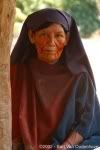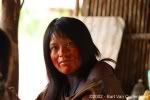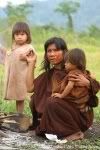
When my mother was in the hospital giving birth to me, my father was in the jungles of Peru, in the province of Huanuco, setting up a post from which to clear the rain forest, build roads, establish cattle ranches and evangelize the natives. When I was just a couple of months old, my mother, eighteen month old sister, and I joined him. I lived there the first few years of my life and then we moved to Lima, where we stayed until I was 7.
Like most people, I have very few actual memories of the first few years of my life. And its hard to distinguish what I do remember from the 8mm home movies that were made of us to send back to my grandparents in the US. I think it was pretty rough going for my mother and an attempt by my father to prove himself worthy to his boss, my grandfather.
As an adult, I’ve been so ashamed of this family history, that I’ve never wanted to talk to my father about what he was doing. I just wanted to put it in the past and move on. This last week I’ve decided to take my own journey and do some exploring on the internet to see what I can learn about the area and the people who live there.
From what I’ve been able to tell, the people where we lived are Ashaninka which means “a brother to all.” They are described as fierce and independent in their struggles with the Spanish conquistadors and have since then had to deal with slavery in the rubber plantations, colonizers like my family, and the battles between the Peruvian government and the communist rebels known as Shining Path. Here’s a few photos thanks to Bart VO:



One of the last times I remember talking to anyone in my family about what was happening in this area, I heard that no one could visit where we had lived because the Shining Path was in control and US citizens would be targeted. That was in the late 80’s.
Most people might recall that in 2000, then President Alberto Fujimori, who had assumed dictatorial powers to defeat the rebels, and also to cover his corruption, fled the country. This led to the election in 2001 of Alejandro Toledo, who established a Truth and Reconciliation Commission to explore the most violent conflict in the history of Peru. From 1980 to 1995 approximately 69,280 Peruvians had been killed in this struggle.
In its final report the CVR points at Shining Path as the major perpetrator of human rights violations (torture, kidnapping, assassinations), with the Armed Forces in second place and Túpac Amaru Revolutionary Movement in third. The CVR also criticized the performance of the Catholic Church, especially Archbishop of Ayacucho Juan Luis Cipriani, of the Opus Dei.
Here is a quote about the Commission’s work from its Chair, Salomon Lerner Febres:
We are convinced that a future of peace and democracy is possible and it is in our hands to make it come true if we identify everything that must never happen in our country again, never more subversive violence, never more a war among Peruvians, never more human rights abuse, never more indifference or silence before our countrymen’s misfortune.
There are occasions in which saying no is also a way to affirm. Saying no to injustice is, above all, a way to open the doors of reconciliation.
The Commission put together a photography exhibit titled “Yuyanapaq” which means “to remember” in Quechua, the indigenous language spoken by most of the people who were victims of the violence. Here is what the Commission’s web site says about the exhibit:
The images …reconstruct the history of those violent years, thanks to men and women who, equipped with cameras, decided to register the diverse aspects of the complex reality of the manchaytimpu, or “time of fear”. Many of these images had been ignored or trivialized. The majority of the incidents and protagonists had gone unnoticed or had been forgotten. To recover them and bring them once again to our memory, or register them for the first time, is part of the struggle for truth and reconciliation in which we are immersed.
In 2005, a documentary film titled State of Fear: The Truth About Terrorism was released using much of the information gathered by the Truth and Reconciliation Commission. From the film’s website:
State of Fear takes place in Peru, yet serves as a cautionary tale for a world engaged in a “global war on terror”. It dramatizes the human and societal costs a democracy faces when it embarks on a “war” against terror, a “war” potentially without end, all too easily exploited by unscrupulous leaders seeking personal political gain.
An unforgettable array of characters takes us down a troubling road peopled by perpetrators and victims, and bystanders who only watched as the horror unfolded. But it is also the story of courageous Peruvians who fought to maintain their democracy and defend human rights, and persevered in their quest for truth and justice.
I’ll probably continue to look for information about the people and places that are the distant memories of my childhood. It finally seems important for me to look them in the eye as much as I can – and perhaps learn from them.

5 comments
Skip to comment form
Author
for the movie “State of Fear.”
… to look at such suffering, know your own family’s place in it…and nowadays, every American has to do the same with what we have done not only in Iraq but to folks here in our own country.
It would seem easier to turn away, but I think that is an illusion, tho maybe a seductive one.
I admire your strength and courage to face this, to learn more about it, learn about the people, our brothers and sisters in Peru.
The trailer was awesome, NL, and this story is something that is going on everywhere, it seems.
Author
of the Yuyanapaq photo exhibit with the poem “Masa” by Cesar Vallejo. I looked today for an english translation of the poem on line, but couldn’t find one. If someone knows where I can find one, I’d be much appreicative.